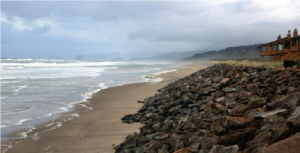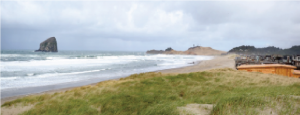
Dundas, OSU
NCCOS supported researchers from Oregon State University (OSU) recently held their project’s 2018 Advisory Board meeting to discuss the project progress and receive feedback on the work’s potential impact on management and decision-making. The project team is investigating the economic, ecological, and geomorphologic outcomes of investments in coastal natural infrastructure of the Pacific Northwest along three research pathways – Estuary Restoration, Coastal Protection, and Dune Landscapes. The meeting was a two-day affair (April 12-13) consisting of a field trip to three locations along the Oregon Coast and a full day of presentations and outreach and engagement discussions at Hatfield Marine Science Center (HMSC) in Newport, Oregon.
The researchers first met with the board in Newport for an overview presentation by project lead Dr. Steven Dundas summarizing research progress. Afterward, the group traveled to three coastal communities illustrative of coastal issues that are the focus of our research efforts to see and discuss firsthand with relevant stakeholders some of the issues identified for the three pathways. Stakeholders at Pacific City learned from project scientists that using a diversity of native grasses might help reduce the need for active dune management. While at Neskowin, the researchers learned from stakeholders that coast armoring is more and more no longer sufficient in protecting properties from Oregon’s winter storms. Finally, at Salmon River, meeting participants discussed how diked tidal wetlands in the estuary are being restored to regain their natural functions, improving water quality and returning habitat for salmon and other plants and animals that rely on the tidal ecosystem.

On the second day, the investigators formally met with the board in the Guin Library at HMSC. The team presented highlights of the most recent results on the three research pathways. The project is advancing the transdisciplinary science of coastal ecosystem services by combining research expertise from OSU in environmental and resource economics, ecology, geomorphology, geomatics, and engineering in an integrative framework. The focus is on coastal natural infrastructure (natural ecosystem components) to understand the nature and determinants of socially optimal investments in natural infrastructure in coasts and estuaries from an economic perspective (i.e., assigning a dollar value to ecosystem services lacking a market price). The economic theory of investment provides the conceptual foundation for the research (i.e., socially optimal investment decisions maximize total economic value). Focusing on natural infrastructure types, including estuaries and dunes, the scientists are measuring the expected benefits, direct costs, and co-benefits of natural infrastructure.
Dr. Steven Dundas, Department of Applied Economics, Oregon State University leads the project. The project research is supported by NCCOS through the NOAA Cooperative Institute for Marine Resources Studies (CIMRS) at Oregon State University.
For more information, contact Felix.Martinez@noaa.gov.
